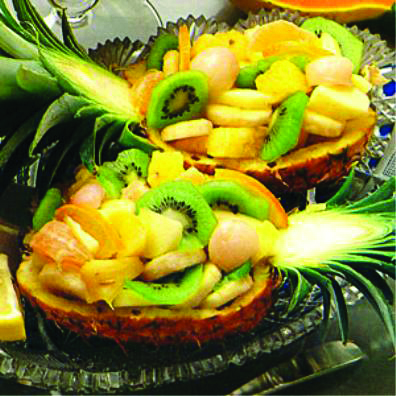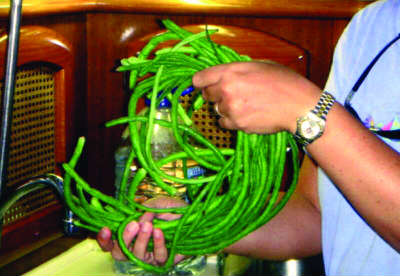
Happy to be the sailing charter executive chef
Since during a sailing charter vacation I’d much rather cook and mix drinks than check the oil, the task of being the Executive Chef often falls to me. Over many years and many sailing charter vacations all over the Caribbean, I’ve learned a few things about provisioning that might serve fellow charterers well, both down island and in the Chesapeake.
The following provisioning tips are merely food for thought and a starting point; the best way to learn how to be an effective galley wench is to get out there and do it!
Be wary of provisioning “packages”
Although the offerings have gotten more sophisticated and tailored, the standard provisioning packages offered by charter companies can be way off the mark. Oftentimes, the ingredients supplied simply don’t fit together, and too much food is provided, leading to waste.
We spent our first bareboat charter, for which we’d ordered “lite” provisioning, trying to figure out what to do with five cantaloupes and five honeydew melons. The dock staff will happily accept un-opened packages of food, or you can pass them along to the next crews arriving for their sail. There are better ways to provision.
Go shopping, or have someone do it for you
The goods available in supermarkets in the more well-traveled islands have improved vastly over the years.
Things have advanced from canned deviled ham and freezer-burned “meat” to a vast array of recognizable foods. Oftentimes, the stores are also stocked with luxurious and exotic products that are imported to the islands but not to the United States, such as Irish butter, fancy French patés, and Italian antipasti.
If you don’t feel like grocery shopping yourself, some of the stores will allow you to order in advance from a long list of items, and for a small fee, will deliver right to your boat. It’s a great feeling to start your charter with all of the food you ordered onboard and stowed, with the cockroach-harboring cardboard boxes removed. If you don’t trust someone to take care of your provisioning, consider using the charter company or a store to take care of the heavy stuff, like water and other beverages.
Go local
One of the reasons to go sailing in the Caribbean is to expand your horizons.
This can include your palate as well. Plan on several meals ashore; the local restaurants appreciate the business and can certainly use it since tourism has declined due to the world economy. If you do so, be sure to reserve in advance so that they know to be open for you.
Most waterfront restaurants monitor VHF 16, but don’t use your boat’s name when reserving, because, in some locales, petty thieves have been known to monitor the radio so they know when a particular boat will be unoccupied. When doing your own cooking, think about incorporating local ingredients. Local hot sauces and seasonings are always a great bet, and every island seems to have many choices. The Sunny Caribbee shop in Roadtown, Tortola has a great selection of spice blends, and I so enjoy their curry and jerk seasonings that in between charters, I order them by the pound and have them shipped to the US.
Similarly, Grenada has a bounty of locally-grown spices, which can be found at every turn, and the produce is excellent (unlike elsewhere). Even better is getting your hands on some fresh seafood. One of my most memorable experiences was buying still-wriggling lobsters from a fisherman in a dugout canoe in the Belize cayes and enjoying them simply grilled for dinner that evening. And the Bahamas, in particular, are known for superlative baked goods—the bread alone is to die for, and the life span of a key lime pie from Vernon’s grocery store in Hopetown (Abacos) is very brief.
Keep it Simple
Few charter crews expect a gourmet spread on a sailboat, so don’t kill yourself providing it. Although Painkillers and margaritas are awfully nice, it’s easy enough to leave those to the professionals ashore and limit your own bartending to wine, beer, and simple cocktails of just a few ingredients (like rum and cola, rum and ginger ale, or vodka and cranberry).
For lunches, I’ve learned that wraps are tasty and useful for using up leftovers and can be consumed underway if you’re still sailing midday.
For dinners, I almost always use the grill, especially if it’s a propane-fired one (it can take a while for coals to get ready in a breezy anchorage). Not only does grilling keep the galley cooler, it also spreads the labor around, since the galley wench can delegate the grilling task to one of the other crew. To reduce dishwashing, I’ve got a handful of recipes that can be assembled in a foil packet and tossed on the grill—think fish, tomatoes, onions, and par-boiled potato slices with a bit of seasoning, olive oil, and lemon juice.
Stick with hardy supplies
Charter boat refrigerators are notoriously unreliable and fickle. While supermarkets are better-stocked now than ever, much of the fresh produce that is available, most of which is imported, is of questionable age and quality. The combination can result in a lot of ruined food, particularly the more delicate or perishable foods, such as lettuce, mushrooms, and lunch meats. If you do buy such items, use them up early in your trip.
Better yet, choose foods that are hardier, many of which don’t require refrigeration. Produce such as cabbage, potatoes, onions, bell peppers, and apples survive the rigors of importation better, are less sensitive to temperature swings in a refrigerator, and can be stored in a basket or locker. Canned tuna (or foil-packed) can be part of a great lunchtime wrap or a pasta salad and has a much longer shelf-life than deli turkey. Hard cheeses seem impervious to abuse.
Many salad dressings—even mayonnaise if handled properly—don’t require refrigeration, saving you fridge space better used for storing ice for cocktails. Bring Along Some Staples. While many charter companies provide a “charter starter” kit of some basic supplies (limited, it seems, to paper towels, a few trash bags, matches, and the ever-important complimentary bottle of local rum), other things that galley wenches are used to having on hand will need to be purchased.
With respect to many of these items, you need to buy a full package just to get that single teaspoon. Rather than waste an entire package, bring along the seasonings and spices that you are likely to use in small zipper bags. In addition, some items simply won’t be available or will be difficult to find; to the extent they are easy to carry (powdered drink mixes, energy bars), bring them along as well.
Alas, one chef’s staple remains problematic: the knife. Knives aboard charter boats are poor excuses for cutting instruments, either because they were never very good to begin with or were abused. Some regular charterers and charter boat owners of my acquaintance actually keep storage lockers in Tortola and keep their special supplies there.
The rest of us have to struggle with airline and TSA luggage restrictions to either bring a good knife with us, or steel ourselves for the likelihood of mangling our food.
Plan ahead
Since I am an early riser, I use morning down time to do a lot of prep in the galley. If the cabin is already being heated up by coffee being made, I’ll also boil eggs or pasta for lunchtime chef or pasta salads or parboil potatoes for later use with dinner. If bacon is part of the breakfast menu, make extra for BLTs.
Plan on ingredients serving double duty: extra grilled chicken from dinner can go into sandwiches or pasta salad. Final Note. None of these suggestions is ground-breaking or even novel. But what is easily done in a kitchen at home takes a lot more effort on a moving platform, with unfamiliar ingredients and subpar equipment. A little planning ahead and ingenuity can help ensure that your crew is happy and that you spend less time in the galley and more time enjoying your vacation.
~ By Eva Hill





